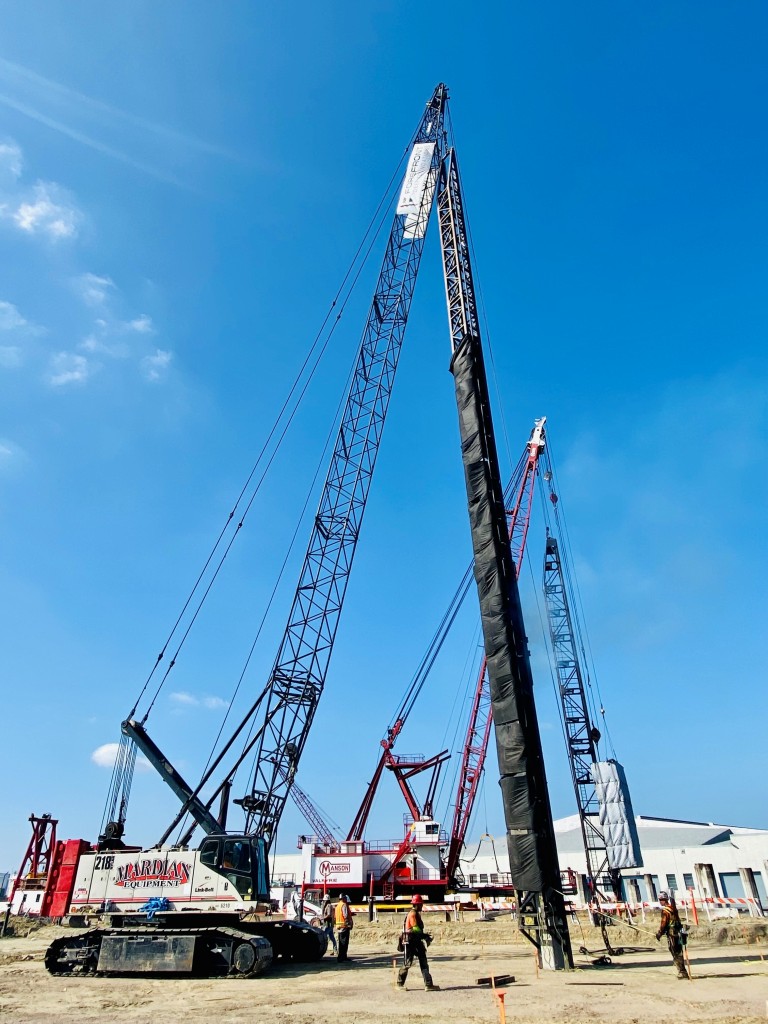When completed in 2023, the new station building will serve as offices, accommodations, and a maintenance shop for the Port of Long Beach Harbor firefighters.
By Lisa Kopochinski

Work remains well underway on the new Fireboat Station project for the Port of Long Beach Fire Department in Long Beach, Calif.
With a completion date slated for Spring 2023, Forefront Deep Foundations began probing work on the $31.6 million project in Spring 2021.
“This project is a result of significant port expansion within recent years,” explains Jeff Bird, President of Forefront Deep Foundations, a PDCA member company based in Newport Beach, Calif.
“This site is located at Pier Berth D50 at Pier D where the site has served multiple purposes since it was originally developed in the 1920s. Based on geotechnical investigations of the site, it has been discovered that the new Fireboat Station site is underlain with an existing quay wall, timber piles, a timber wharf structure, and miscellaneous concrete structures.”
In order to provide proper foundation support for this project, Corner Structural Engineering designed the boat house dock to be supported on 24-inch concrete octagonal piles, and the Fireboat Station to be supported on 16- inch concrete square concrete piles.
“Forefront’s role was to furnish and install the landside piles for the new Fireboat Station building,” says Bird. “The building will serve as offices, accommodations, and a maintenance shop for the Port of Long Beach Harbor firefighters.”
Scope of Work
Forefront Deep Foundation’s scope of responsibilities on this impressive project included the following:
- Performing probing and pre-drilling work at all future pile locations;
- Furnishing and installing 16-inch square concrete piles for the Fireboat Station Building while meeting project noise mitigation requirements;
- Cut-off piles in 1-foot to 25-foot lengths that reached refusal during installation, and;
- Furnishing and installing epoxy coated # 8 anchor bars in dowel tubes that were in the piles.
The company began probing work last spring and completed the project (dowel installation) last fall. The team used the following piledriving equipment on this project:
Pile Probing
- APE 150 Vibratory Hammer
- 90-ton RT Crane
Pile Driving:
- APE D-36 Diesel Impact Hammer with 26-inch swinging leads
- Link-Belt 218 110-ton Crawler Crane
- Custom-made sound blanket attached to pile driving leads to meet rigorous sound mitigation requirements
As for the number of piles driven for the actual foundation, Bird doesn’t miss a beat.
“Forefront installed 78 total 16-inch square concrete piles in 15-foot to 78-foot lengths for the Fireboat building. The first pile installed had Pile Driving Analyzer (PDA) monitoring in order to confirm that the required pile design capacities had been met. Manson Construction—the water piledriving contractor—installed 77 total 24-inch octagonal concrete piles in 86-foot to 100-foot lengths for the Fireboat dock.”
Project Challenges
From a piledriving standpoint, this project did present some unique challenges for the team.
“For example, there were challenges with installing piles on a site with existing wharf structures, timber piles, and concrete structures built in the 1920s and 1930s,” explains Bird.
“This required ‘probing’ 35 feet in depth to find the top of the wall elevation prior to determining the pile lengths, which ranged from 30 feet to 78.5 feet.”
The project also had stringent noise mitigation requirements that exceeded the specifications of typical sound blankets.
“In order to meet the project requirements, Forefront had to get creative,” recalls Bird.
“We developed a system that was comprised of a mass loaded vinyl material for Sound Transition Class Rating (STC) attached to two layers sound blankets for Noise Reduction Coefficient (NRC). This custom fabricated system of combined materials met the sound mitigation requirements of .9 NRC and a 28 STC. The system worked fantastic throughout the duration of the project. I’m proud of our team’s innovation to successfully solve this challenge. That’s what we do best—address and solve challenges.”
Forefront was also required to pre-drill and probe at all pile locations as a preliminary phase of work in order to determine the depth of existing structures.
“There was great concern that if the piles were too long, they would damage the existing quay wall, which was believed to be 20 feet to 30 feet below existing grade,” says Bird.
“Upon review of the data from the probing and drilling, the geotechnical engineer provided the concrete pile cast lengths for the future Fireboat Station Building.”
There were also strict local hire and apprentice requirements where each contractor was required to hire workers within a 50-mile radius of the project.
“We were able to work with the Pile Drivers Local 562 based out of Long Beach to ensure that this requirement was met,” says Bird.
“In addition, Forefront employed multiple apprentices in order to meet the ratio requirements for this specific project. We were very proud to be able to employ apprentices on this project who will one day become the future leaders in our industry.”
Additionally, there was also a mandatory small business requirement on this project to have 20 percent participation of contract value.
“Due to the fact that Forefront Deep Foundations is a certified Small Business Enterprise by the California Department of General Services, we were able to contribute 100 percent of its contract amount to assist in meeting the general contractor’s SBE requirements,” says Bird.
In all, he adds that Forefront is honored to work on a project that will benefit our country’s first responders.
“We were proud to be able to employ apprentices on this project who will one day become the future leaders in our industry.”
